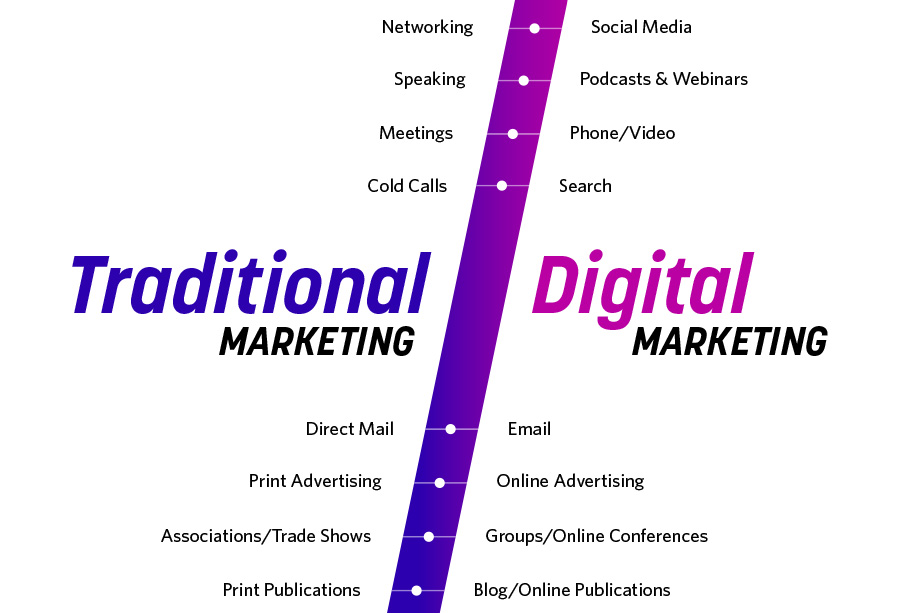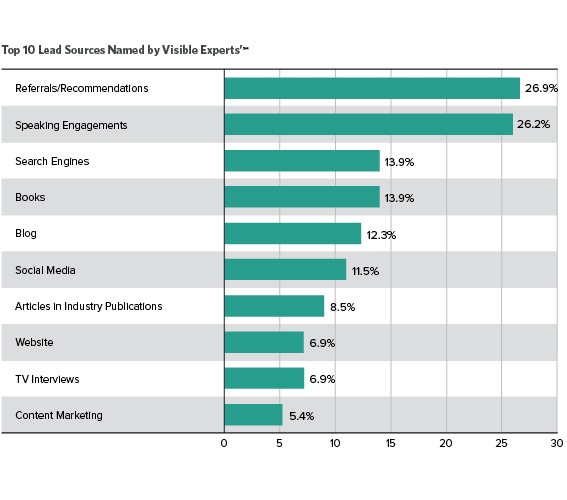Digital marketing has become the go-to platform for many professional services firms. Compared to traditional marketing, online techniques are easier to measure and often less expensive than their traditional marketing counterparts.
Yet many offline marketing tactics can be powerful tools to build and support your firm’s online brand. According to our research on the best performing professional services firms, the most effective marketing strategies—those that deliver the most impact and faster growth—include a roughly balanced combination of online and offline techniques.
How online and offline marketing techniques work together to support brands
When implemented in concert, online and offline marketing ideas support and amplify one another, creating a unified strategy. In the most recent release of our annual research study on high-growth strategy, we uncovered which marketing techniques deliver the greatest impact. Below, I’ll discuss five of those offline marketing techniques and how you can integrate them into your overall marketing strategy. Of course, every industry is different, so you may find that one or more of these techniques is less relevant to your audience. If another tactic has worked for you in the past, by all means keep using it.

Below are five offline marketing ideas—techniques used by today’s fastest growing firms—to get you started. How many of these do you use already?
1. Networking Activities
Face-to-face connections, even virtual ones, continue to play a valuable role in networking. What’s more, they can help drive traffic to your website, allowing the contacts you’ve made in person to learn more about you and your firm.
In many cases, a good clean handshake is still important — being able to “put a face with a name” removes a level of abstraction from your brand and makes your firm more approachable. But choose your opportunities wisely. Seek out associations or organizations to which your target audience belongs.
2. Attend Association Conferences and Trade Shows
Trade shows can provide opportunities to network with both prospective buyers and other industry leaders. In addition, these events can offer other offline marketing opportunities — for instance, they are ideal places to distribute printed marketing materials or explore the possibility of becoming a future featured speaker. Which brings me to the next technique.
3. Speaking Opportunities
Speaking engagements put you directly in front of a highly targeted audience that is primed and ready to hear what you have to say. And they are a proven way to establish your firm’s credibility and thought leadership. According to our research, speaking engagements are the second-most popular way that Visible Experts® acquire leads.

If you’re just starting on your journey to thought leadership, however, don’t expect to secure prime speaking engagement opportunities right off the bat. Instead, start small by approaching an association’s local chapter. And don’t expect to be paid for these initial forays (for that matter, many national gigs are unpaid or cover only travel expenses). By adjusting your expectations, even your earliest experiences can pay off in the long run.
4. Warm Calling
While not as common as they once were, calls to prospects provide an opportunity to add a human touch to your marketing, and many firms make them a regular feature of their business development program because they work. More personal than emails, phone calls require an instant response — which, unfortunately, can cut both ways. In our most recent research, phone calls are experiencing a renaissance, especially among the fastest growing firms.
High-growth firms are having particular success with so-called “warm calling.” Unlike cold calls, which are a low-yield numbers game, warm calls deliver more frequent, better-quality results. A “warm” prospect is one who not only is aware of your firm but has been exposed to your thought leadership — usually through digital channels like your website, social media or email marketing, though offline avenues such as speaking engagements or books can also build engagement. Some firms even use the call itself as an opportunity to offer the prospect a piece of valuable content or advice to make their expertise more tangible.
5. Demos/Consultations
Live, personal demos and consultations provide a direct connection between buyer and seller. As a result, they are one of the most effective bottom-of-the-funnel tools — of any kind. They allow a prospect to directly experience your firm’s expertise and/or product. But these activities are more likely to turn into new business when they are set up by other marketing interactions. When a prospective buyer has already visited your firm’s website, read multiple blog posts, downloaded a white paper or executive guide and received relevant educational content by email, they are far more inclined to buy. After all, they already know and trust your firm. Often, a live demo or free consultation provides the extra confidence a buyer needs to request a proposal and move forward toward a contract.
Why offline marketing strategies work
Why do traditional techniques continue to work in our increasingly digital marketplace? Despite all of the technological advances of the past three decades, the professional services remain built around delivering expertise. That means people trusting the advice and critical services delivered by experts. And because most professional services are big-ticket investments, buyers want to meet the teams they will be working with for month or years.
Other traditional techniques have different advantages. For instance, because direct mail is largely out-of-fashion today, it may be more likely to capture a recipient’s attention—less competition in this channel means less distracting noise. Print advertising can reach a very targeted audience (in an industry magazine or conference brochure, for instance) or a less targeted but large audience (such as a national newspaper), depending on your strategy. And print collateral provide a tangible experience that digital channels lack.
Do traditional techniques offer any of the advantages of digital ones? For instance, can a/b testing be applied to offline marketing strategies? In general, the answer is no, though there are certain situations in which you could conduct an a/b test. For instance, if your list were large enough and if your timeline was sufficiently long, you could send out two printed promotions containing different messages or calls to action to a subset of your list. Using coupon codes or two separate landing pages, you could test which performed better, then send the winning piece to the remainder of the list. In practice, however, this kind of test is rarely practical. Either your list is too small to produce a statistically valid response in the early round or the cost of creating two separate pieces is prohibitive. But as we have seen, offline techniques have their own set of advantages.
Combining strategies for better results
Fortunately, you don’t have to choose between online and offline marketing strategies. In fact, using both is more powerful. By combining the two approaches, you can bring your marketing full circle — increasing your firm’s visibility and, at the same time, attracting more attention to your online brand.
How Hinge Can Help
Hinge is a global leader in helping professional services firms grow faster and become more profitable. Our research-based strategies are designed to be implemented. Our High-Performance Website program is designed to give your firm every advantage in the marketplace—from spelling out your value proposition to generating a steady stream of qualified leads.
Additional Resources
- Learn the strategies for creating a high-growth professional services firm. Download our free book, Spiraling Up.

